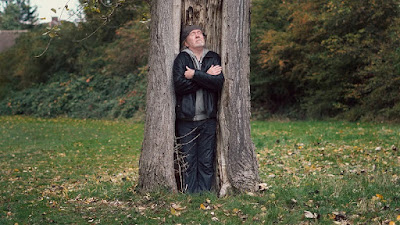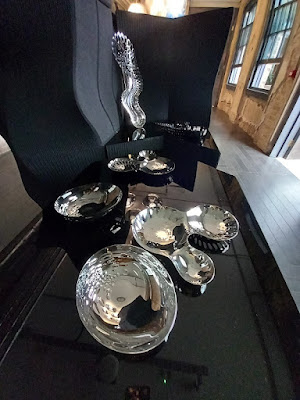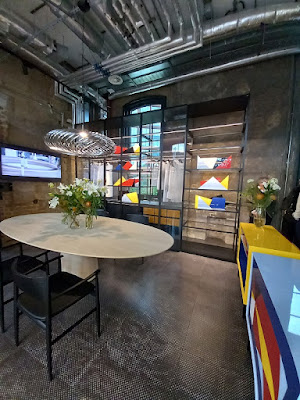The East Sussex art gallery Towner Eastbourne is celebrating its centenary, and the cherry on the cake for its year-long celebration is its hosting of an exhibition showcasing the work by the four shortlisted artists nominated for the international Turner Prize 2023, the world’s leading prize for contemporary art.
The four shortlisted nominees for Turner 2023 on show at Eastbourne Towner are British artist Barbara Walker; Rory Pilgrim, who works between the UK and The Netherlands; Jesse Darling, who lives and works in Berlin and London; and London-based Swedish artist Ghislaine Leung.
Joe Hill, Director and CEO of Towner Eastbourne welcomed the Turner Prize 2023 to Eastbourne, as the centrepiece of Towner Eastbourne's Centenary year. "Founded as 'an art gallery for the people,' the gallery has always championed living artists and has been at the forefront of showcasing and collection contemporary art in the UK, said Hill. "What better way to celebrate this legacy than to bring one of the world's best-known prizes for the visual arts to the region."
Alex Farquharson, Director of Tate Britain, and chair of the Turner Prize 2023 jury, said. "Jesse Darling, Ghislaine Leung, Rory Pilgrim and Barbara Walker have remarkably varied approaches to creating art that actively responds to and reflects the world around us - engaging with the social, economic, cultural and political issues of our time. The Turner Prize offers a fascinating snapshot of contemporary British art now, and a key part of its popularity is its ability to spotlight the rich cultural offerings of our towns and cities on its travels to a truly unmissable movement in Turner Prize history. I look forward to this year's exhibition being enjoyed by East Sussex's residents and visitors alike."
The Turner Prize* exhibition is now open and free to view until April 14th 2024, spanning galleries and spaces across all three floors of the Towner. In the Welcome Space on the ground floor, visitors are urged to see films on the individual artists’ practices, with information on the history of the Turner Prize and details about the rest of Towner’s programme, including artist talks.
The winner of this prestigious prize will be announced at an award ceremony on December 5th, to take place next door in the iconic "Winter Garden", a Grade II listed events building, designed by architect Henry Currey and built by the seventh Duke of Devonshire in 1875.
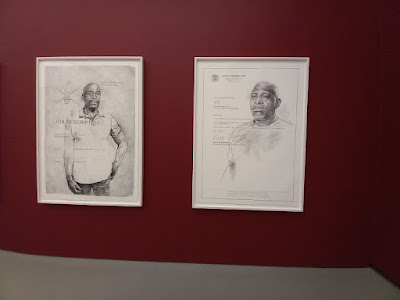 |
| Two of Barbara Walker's Proof of Burden portraits (2022) in mixed media with graphite, conte, charcoal and pastel on paper. |
Finalist Barbara Walker works in a range of media and formats, from embossed works on paper to paintings on canvas and large scale charcoal wall drawings. Growing up in Birmingham, Walker's experiences have shaped a practice concerned with issues of class and power, gender, race, representation and belonging.
Walker was nominated for her presentation entitled Burden of Proof at Sharjah Biennial 15. In this body of work, Walker brings careful attention and visibility to individuals and families affected by the Windrush scandal.
For the exhibition at Towner, Walker's presentation features large scale charcoal figures drawn directly onto the gallery wall, demonstrating the artist has a bold statement and a strong message to make. On the adjacent walls is a series of works on paper.
Walker's monochromatic portraits feature people who were impacted by the Windrush scandal and each portrait is layered over by hand-drawn reproductions of documents that evidence their right to remain in the UK.
These intimate portraits invite the viewer to come face to face with real people whose struggle for legitimacy to remain in the UK and to consider the true consequences of political decision-making and the complexities of diasporic identity.
The jury applauded Walker's ability to use portraits of monumental scale to tell stories of a similarly monumental nature, whilst maintaining a profound tenderness and intimacy across the full scope of her work.
Rory Pilgrim is a multi-disciplinary artist working across song writing, composition, films, texts, drawings, paintings and live performances. Pilgrim aims to challenge the nature of how we come together, speak, listen and strive for social change through sharing and voicing personal experience.
Rory Pilgrim was nominated for the commission RAFTS at Serpentine and Barking Town Hall, and a live performance of the work at Cadogan Hall, London. Pilgrim's presentation "Rafts (2022" on the first floor at the Towner is a hour-long film featuring a seven-song oratorio narrated by eight residents of Barking and Dagenham in London from Green Shoes Arts, reflecting on what the symbol of a raft means to them through song, music, animation and poetry. They are joined by singers Declan Rowe John, Robyn Haddon, Kayden Fearon and members of Barking and Dagenham Youth Dance. The film is a soulful, emotional body of work made during the Covid-19 pandemic and the raft is positioned as a symbol of support keeping us afloat in challenging and precarious circumstances.
Timed screenings of Rafts and Rafts: Live are presented with paintings, drawings, writings and sculptures in the same room and in the space outside the room that expand on the theme.
 |
| Rory Pilgrim's Putting The World To Bed, 2021, on oil, crayon and nail polish on wooden panel. |
The jury praised the film project as a standout example of social practice. They felt that Pilgrim's beautiful and affecting musical arrangements gave light to their collaborators' voices and that the confidence and vulnerability of the performance reflected the strength of the relationship between artist and community.
Jesse Darling works in sculpture, installation, video, drawing, sound, text and performance, using materlialist poetics to explore and reimagine the everyday technologies that represent how we live. Darling has often combined industrial materials such as sheet metal and welded steel with everyday objects to explore ideas of the domestic and the institutional, home and state, stability and instability, function and dysfunction, growth and collapse.
 |
| Jesse Darling's installation showcase metal pedestrian barriers that appear to have legs that walk across the room |
 |
| Ghislaine Leung, Fountains. Installation View at Simian, Copenhagen, Denmark, 2023. Courtesy the artist and Simian, Copenhagen; and Maxwell Graham, New York; and Cabinet, London. Photo credit GRAYSC. |
Ghislane Leung's practice takes a critical look at the condition of art production, its presentation and circulation. Leung has developed a process of art making that results in "score-based artworks". The "scores" are text-based instructions or descriptions that are realised by the gallery team in close conversation with the artist.
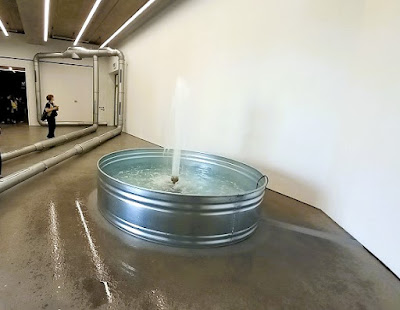 |
| Ghislane Leung's Fountain |
Leung was nominated for her solo exhibition Fountains at Simian, Copenhagen. Leung's work takes the form of "scores" - sets of instructions which test the boundaries of the gallery space. Fountains (2022) is an artwork created from a score that simply states "a fountain installed in the exhibition space to cancel sound".
At Towner, Leung's presentation also features a baby monitor installed in the art store, broadcasting live to the exhibition space, and a wall drawing representing the hours that Leung can dedicate to working in her studio. There is also a row of children's toy houses and toy household items. These installations reflect on the realities of an artist role as a mother and highlight her interest in the time, labour and support structures required to make and maintain artworks.
The jury particularly commended the warm, humorous and transcendental qualities that lay behind the sleek aesthetic and conceptual nature of Leung's work, as well as her commitment to challenging the way art is produced and circulated.
*Turner Prize, one of the best-known prizes for the visual arts in the world, aims to promote public debate around new developments in contemporary British art. Established in 1984, the Prize is awarded to a British artist for an outstanding exhibition or other presentation of their work in the previous twelve months.
Members of the Turner Prize 2023 jury are Martin Clark, Director, Camden Art Centre; Cédric Fauq, Chief Curator, Capc musée d’art contemporain de Bordeaux; Melanie Keen, Director of Wellcome Collection; and Helen Nisbet, Artistic Director, Art Night. Alex Farquharson, Director of Tate Britain, was chair of the 2023 jury.
The Turner Prize winner will be awarded £25,000 with £10,000 awarded to the other shortlisted artists.
The Turner Prize, established n 1984, aims to promote public debate around new developments in contemporary British art. It is named after the renowned British painter JMW Turner (1775-1851) and is awarded each year to a British artist for an outstanding exhibition or other presentation of their work.
Turner Prize 2023 is curated by Noelle Collins, Exhibitions and Offsite Curator at Towner Eastbourne. It is one of the major events of Towner 100, a year-long centenary celebration of arts and culture across Eastbourne. Towner Eastbourne kicked off the year of celebration with Barbara Hepworth: Art & Life earlier this year until September 2023. Coinciding with the Turner Prize is Eastbourne ALIVE - a wide range of public art commissions and events taking place across the town.
All photos at the Turner Prize 2023 exhibition/ Towner Eastbourne by Lucia Carpio. Others are appropriately credited.




